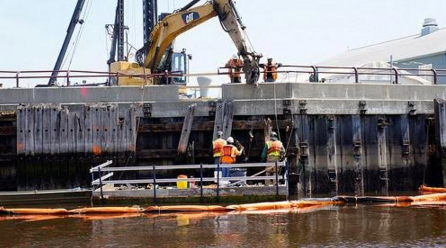Bulkhead Repairs
Bulkheads are vertical retaining walls intended to hold soil in place, stabilizing a bank or shoreline. Replacements and repairs of bulkheads typically follow the existing grade and requirements of the original structure.
To conform to regulation, bulkhead repairs, when complete, should be “in-kind” and “in-place” – that is, the repair does not alter the size, shape, or placement of the structure. Preferably, there should be little or no extension waterward (towards the water) from the existing structure. If you cannot avoid waterward expansion, you must consider the effect on the aquatic environment.
Bulkhead Repair Project Details
- Permits You’ll Need
- Project-Specific Application Requirements
The following are some specific application requirements for construction and maintenance of bulkhead structures.
Project Description
If your bulkhead repair will result in any waterward expansion beyond the current limits of the existing structure, you must justify the purpose and need of the expansion. (Note that in this case, your project will be treated as a new shoreline stabilization project and may not qualify for the type of permits discussed above, such as a Nationwide Permit from Army Corps. It may also then require mitigation of unavoidable impacts to the environment, and an individual permit from the Army Corps.)
Guidelines on Drawing Information/Content for Bulkhead Projects
See NYS DEC’s Drawing Checklist for Bulkhead Projects for a list of what to include on each drawing listed below:
- Drawing Set Cover Sheet (recommended for projects with numerous drawings)
- Site Location & Vicinity Map
- Site Photos and Photo Location Map
- Existing Site Conditions Map
- Proposed Site/Project Plan
- Cross Sections and Details
- Agency Contacts
- Resources
Project Design
Guidelines for Design of Structures along NYS Coastlines
New York State Department of Environmental Conservation
General guidelinesProtection Against Wave-based Erosion
New York State Department of Environmental Conservation
A technical guideUrban Waterfront Adaptive Strategies
New York City Department of City Planning
An in-depth study on alternative approaches to shoreline stabilization in New York CityMaintenance and Repairs
Extract: Tidal Wetlands Guidance Document Link
New York State Department of Environmental Conservation
Guidelines by the NYS DEC on functional waterfront structures, including precise definitions and alternatives to in-place replacement and repairs. See the section on “Replacement of Hard Shoreline Stabilization Structures”
